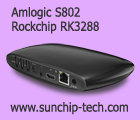They make over 200 Mp3 players and PMPs, now they also make tablets.
Arnova 10 capacitive RK2918 to be released in May
Here’s the Arnova 10 with capacitive touch screen and the RK2918 ARM Cortex-A8 processor. At around $229 MSRP it could possibly become one of the best value 10.1″ ARM Cortex-A8 capacitive tablets on the market. It’s thin, uses most of the nice design features of the Archos 101 Internet Tablet released in October 2010, but removes the kick-stand (to lower cost), replaces some of the metallic design features with plastics (to lower cost), removes HDMI output (I need to let them confirm this, perhaps that was just removed on the prototype). This device uses the new 1.2Ghz Rockchip processor, with 1080p video codecs support (possibly all codecs at up to over 30mbitps high profile playback), new better graphics performance, but most importantly, this awesome 10.1″ tablet may be sold around $229/229€ at retail MSRP (with capacitive and rk2918), and there is a good chance Rockchip should be getting access to the Honeycomb source code soon (comon Google, give it to them sooner rather than later! (I have no idea if Rockchip has Honeycomb yet or not, I will try to interview Rockchip again about Honeycomb at China Sourcing Fair tomorrow)).
Trend Technology (HK) Ltd does Android Tablets
A discussion with a Tablet industry salesman at Trend Technology (HK) Ltd about how it works for them to get those tablets made and distributed.
Uptek International Co Ltd makes Android TV Set-top-box
Uptek explains how they are doing their Android based set-top-box with customized UI solutions, and even VOD stuff.
Topun puts Android in LCOS Pico projector
They make some LCOS pico projectors, they are now also experimenting with including Android in the pico projector.
Jiayinking turntable player, encodes to Mp3
Retro LP turntable players with upgraded digital features like record to USB or SD card, CD burner/player, and some other stuff.
Hello Kitty in Hong Kong
OK, now look forward to having hello kitty on all your home appliances. Prepare to be surprised!
Commax 7″ 4:3 Telechips ARM11 9902 $155 tablets
Here’s http://commax.cc they also do Telechips ARM11 based tablets.
Archos 7c Home Tablet, RK2918 Capacitive
Welcome to Archos Shenzhen offices, Sandy Chen is Archos OEM sales director, she introduces the new Archos 7c Home Tablet, an updated Archos Home Tablet with capacitive screen and RK2918 ARM Cortex-A8 performance chip inside.
HKTDC Electronics Fair – Day 1
The first day of the Hong Kong HKTDC Electronics Fair is over, it’s huge, gigantic, I filmed a bunch of videos that I am now going to upload and publish as soon as possible. Look for cool new ARM Cortex-A9 products, new ARM Powered tablets, Smartphones and much more coming up. Make sure to subscribe to my RSS feed and subscribe to my YouTube channel to keep updated with my latest upcoming videos.
Review: $120 Hero H2000 MTK6516 Android Froyo Powered iphone4-copy
I actually found this being sold at 780 renminbi ($120) at the Shenzhen Electronics Market the day after I bought it. So the price for this is actually as low as that. Also see my video review of the similar but even cheaper $87 FG8 3.5″ capacitive MTK6515 HTC Desire clone. And my video interview with Karasnn.com the probable manufacturer of this $120 MTK6516 Hero H2000 smartphone.
Here are the specs for this cool $120 Android Powered iphone4-copy:
Hero H2000
MTK6516 ARM9 460Mhz + 250Mhz DSP
Android 2.2 Froyo
2GB Flash storage, MicroSD expansion
3.5″ HVGA Capacitive touch screen
GSM/GPRS/EDGE Dual-SIM card slots (no 3G)
WiFi, Bluetooth 2.1, 3.5mm stereo heaphones, 2 Megapixel back-facing, 0.3Megapixel front-facing cameras
I bought one of my H2000 from Sinoteck for $149 (969 renminbi) at http://bysino.net a partner of http://dhgate.com (they were exhibitor at the Shenzhen Electronics Fair) and the other I bought for $131 (850 renminbi) on the Shenzhen electronics market, then finding it being sold for $120 (780 renminbi) the day after.
Rockchip RK2918 for Smartphones
Rockchip is moving strongly into bringing high-end smartphone functionality into the $200-$300 mid-range smartphone pricing, with 3G support and more. They are also providing their RK2818 series for sub-$100 Android smartphones with ARM9 performance.
EkenInd.com new tablets
Eken shows their newest Android tablets, they also have a nice looking Honeycomb logo at their booth, but no Honeycomb actually in sight. I guess we’re all just waiting waving the honeycomb flags until the Google decides to bring it to us all.
Chang Jiang Android Smartphones
Chang Jiang make some of the Mediatek 6516 based Android phones available in the Shenzhen market.
Karasnn.com Hero Android MTK6516 Smartphones
They seem to be the guys making my Hero H2000 Android 3.5″ capacitive $120 iPhone4-copy smartphone.
ZXD $79 Android Phone
Cheap Android smartphones based on MediaTek MT6516 dual-sim GSM.
iida mobile makes Android Smartphones
Here are some Android Mediatek 6516 smartphones, they have different designs, resistive and capacitive.
Erathink.com Intel z550 Windows tablet
Some thin looking Intel Atom x550 tablets, but they are still heavy, probably expensive, and probably don’t get very long battery runtime.
Geniatech explains their AmLogic Cortex-A9 Single Core Set-top-box
Shenzhen Geniatech shows a pretty impressive ARM Cortex-A9 AmLogic (Single Core 800Mhz) Set-top-box which they have told me can actually be sold in bulk starting at $70, here I interview their product manager about their status, where they want to bring this product, if he thinks they could be getting Google TV software for this.
Related articles
- Geniatech Android TV Set-Top-Box (armdevices.net)

Rayology.com $135 ARM Cortex-A9 Dual-Core 7″ Capacitive Tablet
This is the first tablet that I have seen that is using the Renesas/NEC 1.2Ghz ARM Cortex-A9 Dual-Core processor platform (Renesas and NEC are collaborating on this ARM Cortex-A9 Dual-Core processor targeted at consumer electronics devices). I wonder how good this $135 Dual-Core Cortex-A9 tablet performs, I’ll try to get a sample to review further for you later during the next few days. Let me know what needs to get tested on this in the comments.



